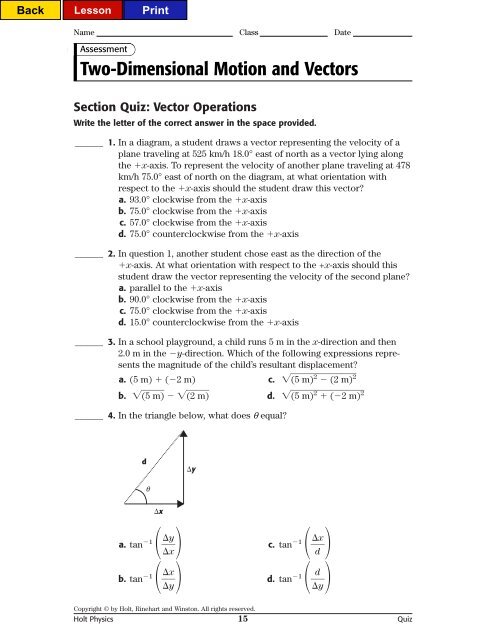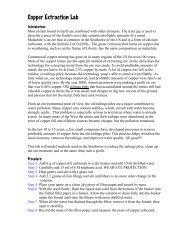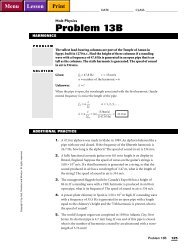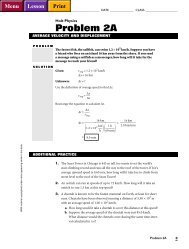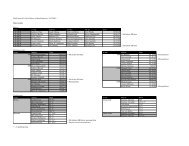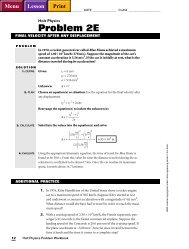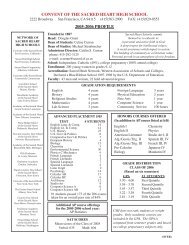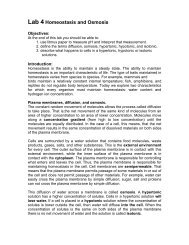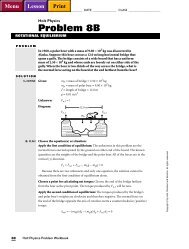Section Quiz 3-2 - Schools of the Sacred Heart
Section Quiz 3-2 - Schools of the Sacred Heart
Section Quiz 3-2 - Schools of the Sacred Heart
Create successful ePaper yourself
Turn your PDF publications into a flip-book with our unique Google optimized e-Paper software.
Name Class Date<br />
Assessment<br />
Two-Dimensional Motion and Vectors<br />
<strong>Section</strong> <strong>Quiz</strong>: Vector Operations<br />
Write <strong>the</strong> letter <strong>of</strong> <strong>the</strong> correct answer in <strong>the</strong> space provided.<br />
______<br />
______<br />
______<br />
______<br />
1. In a diagram, a student draws a vector representing <strong>the</strong> velocity <strong>of</strong> a<br />
plane traveling at 525 km/h 18.0° east <strong>of</strong> north as a vector lying along<br />
<strong>the</strong> x-axis. To represent <strong>the</strong> velocity <strong>of</strong> ano<strong>the</strong>r plane traveling at 478<br />
km/h 75.0° east <strong>of</strong> north on <strong>the</strong> diagram, at what orientation with<br />
respect to <strong>the</strong> x-axis should <strong>the</strong> student draw this vector<br />
a. 93.0° clockwise from <strong>the</strong> x-axis<br />
b. 75.0° clockwise from <strong>the</strong> x-axis<br />
c. 57.0° clockwise from <strong>the</strong> x-axis<br />
d. 75.0° counterclockwise from <strong>the</strong> x-axis<br />
2. In question 1, ano<strong>the</strong>r student chose east as <strong>the</strong> direction <strong>of</strong> <strong>the</strong><br />
x-axis. At what orientation with respect to <strong>the</strong> +x-axis should this<br />
student draw <strong>the</strong> vector representing <strong>the</strong> velocity <strong>of</strong> <strong>the</strong> second plane<br />
a. parallel to <strong>the</strong> x-axis<br />
b. 90.0° clockwise from <strong>the</strong> x-axis<br />
c. 75.0° clockwise from <strong>the</strong> x-axis<br />
d. 15.0° counterclockwise from <strong>the</strong> x-axis<br />
3. In a school playground, a child runs 5 m in <strong>the</strong> x-direction and <strong>the</strong>n<br />
2.0 m in <strong>the</strong> y-direction. Which <strong>of</strong> <strong>the</strong> following expressions represents<br />
<strong>the</strong> magnitude <strong>of</strong> <strong>the</strong> child’s resultant displacement<br />
a. (5 m) (2 m) c. (5 m) 2 m) (2 <br />
2<br />
b. (5 m)<br />
(2 m)<br />
d. (5 m) 2 2 (m) 2<br />
4. In <strong>the</strong> triangle below, what does q equal<br />
d<br />
y<br />
q<br />
x<br />
<br />
x<br />
y<br />
1 a. tan y<br />
x<br />
b. tan 1 <br />
<br />
y<br />
1 c. tan x<br />
d<br />
1 d. tan d<br />
<br />
Copyright © by Holt, Rinehart and Winston. All rights reserved.<br />
Holt Physics 15 <strong>Quiz</strong>
Name Class Date<br />
Two-Dimensional Motion and Vectors continued<br />
______<br />
______<br />
______<br />
______<br />
5. The projection <strong>of</strong> a vector along <strong>the</strong> axes <strong>of</strong> a coordinate system is<br />
called<br />
a. a component <strong>of</strong> <strong>the</strong> vector.<br />
b. a tangent <strong>of</strong> <strong>the</strong> vector.<br />
c. <strong>the</strong> resultant <strong>of</strong> <strong>the</strong> vector.<br />
d. <strong>the</strong> magnitude <strong>of</strong> <strong>the</strong> vector.<br />
6. The components <strong>of</strong> a vector are<br />
a. each equal to half <strong>the</strong> magnitude <strong>of</strong> <strong>the</strong> vector.<br />
b. independent <strong>of</strong> <strong>the</strong> orientation <strong>of</strong> <strong>the</strong> vector.<br />
c. perpendicular.<br />
d. vector quantities.<br />
7. A vector that has components that lie along <strong>the</strong> x-axis and <strong>the</strong><br />
y-axis is oriented at angle A measured counterclockwise from <strong>the</strong><br />
x-axis. Which <strong>of</strong> <strong>the</strong> following ranges give <strong>the</strong> values <strong>of</strong> angle A<br />
a. 0° < A < 90°<br />
b. 90° < A < 180°<br />
c. 180° < A < 270°<br />
d. 270° < A < 360°<br />
8. If <strong>the</strong> x-component <strong>of</strong> B equals <strong>the</strong> magnitude <strong>of</strong> B, <strong>the</strong>n<br />
a. both components are equal.<br />
b. B y equals B 2 2<br />
B.<br />
x<br />
c. B y equals zero.<br />
d. B y lies along <strong>the</strong> y-axis.<br />
9. What must you do to non-perpendicular vectors before you can use <strong>the</strong><br />
Pythagorean <strong>the</strong>orem to calculate <strong>the</strong> resultant <strong>of</strong> <strong>the</strong> vectors<br />
10. In a blinding blizzard, a reindeer trudges 310 m 45° east <strong>of</strong> south across <strong>the</strong><br />
tundra. How far south does <strong>the</strong> reindeer move<br />
Copyright © by Holt, Rinehart and Winston. All rights reserved.<br />
Holt Physics 16 <strong>Quiz</strong>
TEACHER RESOURCE PAGE<br />
3Two-Dimensional Motion<br />
and Vectors<br />
VECTOR OPERATIONS<br />
1. c 5. a<br />
2. d 6. c<br />
3. d 7. b<br />
4. a 8. c<br />
9. The vectors must be resolved into<br />
components. Then <strong>the</strong> horizontal component<br />
must be added and <strong>the</strong> vertical<br />
components must be added. The two<br />
perpendicular resultants can now be<br />
added using <strong>the</strong> Pythagorean <strong>the</strong>orem.<br />
10. 220 m<br />
Given<br />
d 310 m 45° east <strong>of</strong> south<br />
Solution<br />
d y dcosq (310 m)(cos 45°) <br />
220 m<br />
3Two-Dimensional Motion<br />
and Vectors<br />
PROJECTILE MOTION<br />
1. d 5. a<br />
2. a 6. a<br />
3. c 7. d<br />
4. a 8. b<br />
9. If <strong>the</strong> object is launched and caught<br />
from <strong>the</strong> same initial vertical position,<br />
its vertical displacement is zero<br />
because it was moving first up and<br />
<strong>the</strong>n down <strong>the</strong> same distance while<br />
moving horizontally during its flight.<br />
10. 2.6 m/s<br />
Given<br />
y 3.0 m<br />
x 2.0 m<br />
Solution<br />
y 1 2 a y (t) 2<br />
t 2 y<br />
a<br />
2 y<br />
<br />
g<br />
y<br />
<br />
v x v avg, x x<br />
<br />
t<br />
x g<br />
2y<br />
3Two-Dimensional Motion<br />
and Vectors<br />
RELATIVE MOTION<br />
1. a 5. c<br />
2. a 6. b<br />
3. d 7. a<br />
4. d 8. c<br />
9. The dummy’s motion relative to <strong>the</strong><br />
camera would be zero. So, <strong>the</strong> dummy<br />
would appear to be at rest with<br />
respect to <strong>the</strong> camera.<br />
10. 0.58 m/s<br />
Given<br />
v dc 0.50 m/s due north<br />
v cb 0.30 m/s due east<br />
Solution<br />
v db v dc v cb<br />
(v db ) 2 (v dc ) 2 (v cb ) 2<br />
v db (v dc ) 2 ) (v 2 cb <br />
(0.50 /s) m 2 m/s) (0.30<br />
2<br />
v db 0.58 m/s<br />
4Forces and <strong>the</strong> Laws<br />
<strong>of</strong> Motion<br />
CHANGES IN MOTION<br />
1. b 5. d<br />
2. b 6. a<br />
3. d 7. c<br />
4. d 8. d<br />
9. 1. Identify <strong>the</strong> forces acting on <strong>the</strong><br />
body and <strong>the</strong> direction <strong>of</strong> <strong>the</strong> forces.<br />
2. Draw a diagram to represent <strong>the</strong><br />
isolated object.<br />
3. Draw and label force vectors for all<br />
<strong>the</strong> external forces acting on <strong>the</strong><br />
object.<br />
(2.0 m) <br />
(9.81 m/s 2 )<br />
<br />
2(3.0 m)<br />
2.6 m/s<br />
Copyright © by Holt, Rinehart and Winston. All rights reserved.<br />
Holt Physics 153 Answer Key


